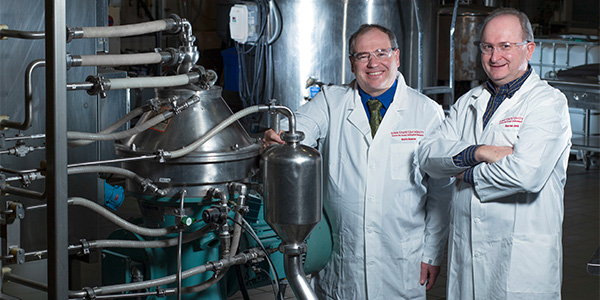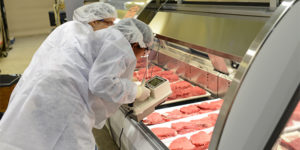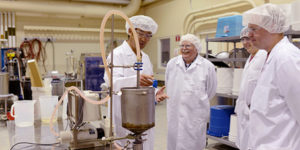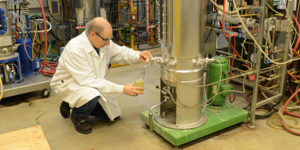
Iowa State’s Industrial Playground
The Center for Crops Utilization Research, along with the Bio-Century Research Farm, provide companies from around the world access to processing and production systems to help take their ideas to the next level.
“Many companies have pilot plants, but they are focused on process improvement and are set up to mimic their largescale manufacturing. Our facility is a playground where they can come and explore new ideas,” says Kevin Keener, director of the two facilities.
Tucked in the Food Sciences Building on the Iowa State University campus, the center offers equipment ranging from lab to pilot plant to pre-commercial scales. It could be considered one of Iowa State’s hidden treasures.
“I feel like, what we’re doing here can change the world,” Keener says. “Most people don’t know we’re here and those who do, don’t realize all the impact we have.”
Iowa focus, global client base
More than 50 companies used the Center for Crops Utilization Research (CCUR), or its affiliated BioCentury Research Farm (BCRF) over the past five years, generating an economic impact of $118 million in Iowa.

The center’s expertise and equipment cover a wide range including the impact of light on meat in retail displays and corn and soy processing for targeted use. (Image CCUR)
About half of CCUR’s clients are based in Iowa, which helps support the center’s goal of diversifying the economy in the state. Iowa State’s Center for Industrial Research and Service is a valuable partner that steers Iowa companies to CCUR.
CCUR has more than 260 pieces of manufacturing equipment that can be configured into integrated systems solutions depending on the needs of the faculty or industrial client. CCUR encompasses 14,000 square feet of lab and pilot-plant space to accommodate companies ranging from start-ups to multi-national corporations.
The center was created more than 30 years ago to increase the use of Iowa crops, which is still a primary focus, Keener says.
“We look at corn and soybeans as an input into all these other opportunities. We don’t just look at them as an agricultural product to feed to animals or make ethanol. The intent is to connect with companies to make value-added products because those products provide a 10-to-1 mark-up on revenue,” he says.
Ideas to implementation
Des Moines-based Kemin Industries had an idea for a new botanical extraction and wanted to evaluate its functionality. To test the feasibility of their idea Kemin turned to CCUR.
“What you want with any pilot is to mimic what will happen in real production. You can do extractions in the lab, but you need to see if it will work in reality, at a larger scale,” says William Schroeder, director of research and development for Kemin’s food technologies division, which markets ingredients that increase the safety and quality of food products.
The company develops some ingredients based on herbs, such as rosemary and spearmint. It wants as much pilot-scale information about growing, harvesting and extracting before actual production.
That’s where CCUR came in.
“CCUR is convenient since it is close. The availability is great; it seems like we can get in on pretty short notice because they can accommodate multiple groups. As far as equipment, they have a wide range of equipment that we can work with,” says Schroeder.
Schroeder says Kemin received enough material from CCUR tests to perform larger pilot application studies on its extraction process, and can better estimate the cost of the process. Optimization is still to be done, and CCUR may enter the picture again.
Human capital, high tech
Schroeder says for Kemin, CCUR’s knowledge base is a major draw.

Hui Wang (left), manager of the pilot plant in the center, and food science professor Lester Wilson (second from left) often include students in research teams in the center including Ethan Wiegle (right). (Image CCUR)
“Hui Wang (the pilot plant manager) and his staff know their equipment and having that assistance helps clients,” Schroeder says. Wang says he enjoys working through clients’ production challenges.
“I have the chance to help technologies move from bench top through pilot scale to commercial scale, troubleshoot the technical issues and help Iowa companies and beyond generate more jobs,” he says. CCUR also offers new businesses needed facilities and experience to develop their ideas.
Wang’s team worked with Nutriati Inc., a Virginia-based company that makes plant-based ingredients from chickpeas and other crops used to boost the protein level of foods or create gluten-free products.
“For a start-up business like ours, it is critical to have access to a pilot plant with the capability to adapt to specific, custom engineering and processes,” says Michael Spinelli, the company’s co-founder and chief technology officer. “Our team was very pleased with the facility layout and the many process capabilities available on site.”
Diverse expertise, equipment
CCUR offers a variety of technologies that commercial research and development departments may need. Many seek information about fermentation from two staffers who have 50 years combined experience with several microorganisms.
Drying technology is another area of emphasis. The center houses eight types of drying technologies that affect the structures of finished products in different ways. Several kinds of grinding systems also are available to handle the qualities of a wide range of materials.

Scientist Bill Colonna draws a sample from a 50-liter fermentor in the Center for Crops Utilization Research. The center offers a variety of technologies commercial research and development departments may need, including fermentation. (Image CCUR)
“A lot of these companies don’t have the diversity of equipment. They can come in here and do the work for a few thousand dollars compared to an investment of a couple hundred thousand for a piece of equipment. That’s the driver for a lot of companies,” Keener says.
Large companies with extensive research and development facilities still seek their help, says Darren Jarboe (’85 ag business, ’86 agronomy, ’12 PhD industrial and ag technology), CCUR’s program manager for technology commercialization, marketing and communication.
“Multi-national companies are innovating all the time and sometimes they like the idea of getting away from the company headquarters and trying new things in an entrepreneurial environment with an extensive assortment of equipment resources and expertise,” he says.
Next gen scientists
Students and faculty researchers are a necessary part of CCUR’s success.
The Iowa State faculty affiliated with the center is a draw for companies, allowing them to access world-class expertise without leaving campus. More than 50 faculty and researchers from departments including food science and human nutrition, agricultural and biosystems engineering and a dozen other departments work with CCUR clients.
Faculty also supervise student research projects in the center. Labs for food processing, food technology and ag and bioengineering students originate in CCUR.
“The equipment we have gives students hands-on exposure to the latest and greatest in terms of technology. In some cases we have students who are part of these research teams. Our assistant pilot plant manager, Ethan Wiegle, is a senior in agricultural systems technology,” Keener says.
Wiegle helps design and set up experiments, maintains equipment and acquires supplies for projects. “I interact with clients, faculty, graduate students and undergraduate students helping to identify their processing needs and how we can help them,” he says.
The experience has given him the opportunity to learn about the food processing industry and network with clients, making contacts for after graduation.
“The knowledge and real life experience I have gained from this job will serve me just as well if not better than the knowledge I have gained in the classroom,” Wiegle says.
Keener says there are currently 10 senior design project and product development teams using the center. CCUR staff help teach undergraduate and graduate courses in areas including food product development, food processing, pet food processing, food analysis and grain processing and handling.
Keener wants to expand training programs for companies using the center including workshops in food safety training, regulatory compliance, packaging and recycling. Last year, it hosted a session on the use of ultrasonics— the use of acoustic vibrations to improve materials and industrial processes—in food processing.
An upgrade to the existing CCUR Technology Transfer Theatre could allow participants to view pilot-plant operations by video, and be broadcast online to sites around the world. It is difficult to view equipment for groups gathered around it, but a camera could put workshops into the pilot plant wherever they are.
“I’ve done a lot of training programs for USDA and FDA inspectors as well as private industry tailored to different company needs, and I see a tremendous opportunity there,” he says.
When he was hired in 2015, Keener says the message he got was to diversify the economy in the state. The variety of projects at CCUR shows it is achieving its goal.



